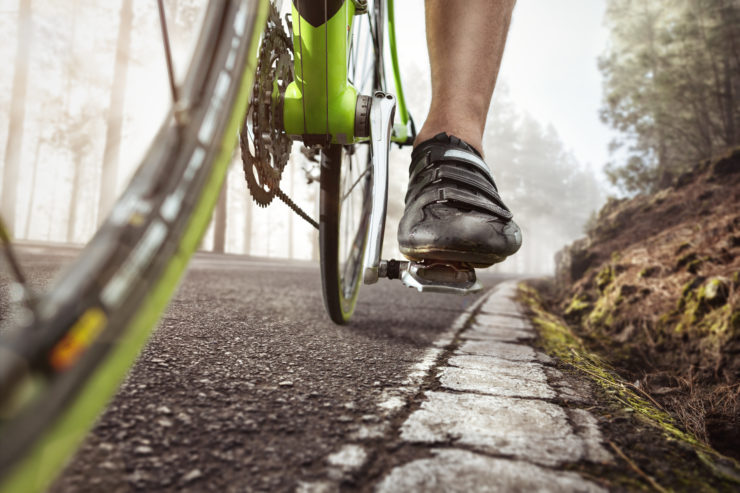ATC 300: When ‘Natural Running Form’ Beats Strict MAF, Stepping Up To 100Ks, and Following Your Body’s Signals To Achieve Your Race Goals
December 6, 2019
Sponsor:
 Ready to go deeper with your health but don’t know where to start and having trouble obtaining blood tests from doctors? Check out Inside Tracker, an awesome service to use for convenient and informative blood testing geared toward athletes. IT uses science and technology to deliver ultra-personalized guidance based on blood biomarkers that span from cholesterol to inflammation and much more. You can get up to 43 biomarkers tested and more on your journey to bettering performance, along with many other features such as your “inner age,’ genetic info, and personalized recommendations. Our favorite is the Ultimate package. Use code “enduranceplanet” for a 10% discount.
Ready to go deeper with your health but don’t know where to start and having trouble obtaining blood tests from doctors? Check out Inside Tracker, an awesome service to use for convenient and informative blood testing geared toward athletes. IT uses science and technology to deliver ultra-personalized guidance based on blood biomarkers that span from cholesterol to inflammation and much more. You can get up to 43 biomarkers tested and more on your journey to bettering performance, along with many other features such as your “inner age,’ genetic info, and personalized recommendations. Our favorite is the Ultimate package. Use code “enduranceplanet” for a 10% discount.
Sponsor:
 You hear us talk about UCAN all the time. Many of our athletes and listeners swear by it. How about you? Maybe you’re ready to try UCAN but don’t know where to start? We have the perfect solution: Click here to get 50% off your UCAN Tri Starter pack. The Tri Starter Pack includes a sample of all the best UCAN products for just $17.50, normally $35. This deal is exclusive to our EP audience and not offered to the general public. It won’t last forever so take advantage while it’s here! For all your other UCAN needs, EP fans get 15% off UCAN, shop now. You can also use the code “enduranceplanet19” if you’re shopping at generationucan.com for that same 15% discount.
You hear us talk about UCAN all the time. Many of our athletes and listeners swear by it. How about you? Maybe you’re ready to try UCAN but don’t know where to start? We have the perfect solution: Click here to get 50% off your UCAN Tri Starter pack. The Tri Starter Pack includes a sample of all the best UCAN products for just $17.50, normally $35. This deal is exclusive to our EP audience and not offered to the general public. It won’t last forever so take advantage while it’s here! For all your other UCAN needs, EP fans get 15% off UCAN, shop now. You can also use the code “enduranceplanet19” if you’re shopping at generationucan.com for that same 15% discount.
On this episode of Ask The Coaches with Lucho and Tawnee:
Intro Banter and Announcements
- Do Our Survey!
- We need your help! Participate in a survey to help us learn more for a new athlete health & nutrition program and be entered to win a 30-min consult with Tawnee for free! The brief backstory: Tawnee has been collaborating with sports nutritionist and registered dietician, Dina Griffin, on a new project, and we want to learn a little more about you to help us fine-tune things. So if you would be kind enough to take this survey we’d sincerely appreciate it. Be sure to add your email and you’ll be automatically entered to win a free 30min consult with Tawnee!
Lee Cordova asks:
MAF – walking “too easy,” running “too hard”
Hey Tawnee and Lucho, hope all is well!! I have a MAF question which means you have probably answered it at some point, but couldn’t find it looking back through the archive, so may be a good topic to cover again!
My wife is getting back in to running after an injury, and has been doing so with a heart rate monitor for the first time. She broke her femur, so it has been a long and slow recovery! The question is about her training that we’ve been working on together – but asked with her permission 🙂
For a while a brisk walk could get her heart rate into a good aerobic/MAF zone, but now walking is too easy – and yet every time she goes into running her heart rate jumps way up. It seems like her MAF pace is in between walking and running. What should she do to build a solid aerobic base, hopefully eventually getting her MAF pace to a 13min/mi? Right now she has been doing run/walk intervals, even though the running is sending her HR above the aerobic zone.
What the Coaches say:
- You’re on the right track with run/walk intervals.
- Plyometrics (hopping and jumping) will help strengthen the muscles that aren’t used to running.
- Stand on one leg and lift your heel a half inch off the floor and hold it until it burns.
- Lunge to knee drive.
- Air squats into walking lunges for thirty minutes.
- Biking would also help (if you do that sport too).
- Walk uphill and run downhill; hike a 3 mile climb then run down.
- Going 5-10 beats over MAF is ok (as long as your perceived exertion is still light) because you’re working on regaining fitness. You’ll see an improvement in your HR after a month of training.
- Running unnaturally is a recipe for disaster, so don’t be a slave to MAF if the slower jog messes with your form.
Kate Brown asks:
Stepping up from 50ks to 100ks
Hi! Having now run 4 small ultras, all around 55kms, I’m contemplating doing a 100km race next September. This would be my best way of getting closure on the ultra trail monte rosa which got half cancelled thanks to snow. I had a thoroughly good time completing the 1st 2 days of the stage race and the 100km race does only the 2nd have of the full course.
I’m curious what changes I should make to my training other than the obvious add in some night running. Attached is the bulk of my run training in the run up to the UTMR and I don’t really envisage adding anymore volume aside from maybe adding in some weight vest hikes.
My lead upto the race is relatively short & constrained by the fact that every year I guide for a week in the Dolomites for a group doing the maratona cycle sportive in early July and bike intensively for the 8wks preceeding, with no energy left for running. However this formula suits my motivation to run. Winters are spent most doing XC skiing and randonnee skiing but I managed 2 snowy runs per wk last year and will likely do the same this winter.
The only other factor for me is; I see a lot of people in uk races basically walking most if not all of the 2nd half of their 100kms and they don’t look like they are having fun. I get the fact that it is gonna hurt at some point but would like to have enjoy the experience as much as possible throughout and walk run a steady race for the whole route if possible. Any suggestions on what I can do to increase the likelihood of this happening. Pacing and sustaining a solid pace is a strength but even so I’m struggling to get my head round how anyone can run 50 more kms after already having done 50.
What the Coaches say:
- Lucho noticed a lot of gaps in your training; run more frequently with lesser miles.
- Also increase the volume of your long runs.
- You’ve got to run up to 50K in your training.
- Biking could play a role in your training. You can bike on rest days, because it doesn’t pound on your joints and break you down. It will fatigue your muscles, though, which can build you up in the long run.
- Track work isn’t essential for an ultra, but 2-3 hours of biking could be massively helpful.
- Running with a weighted vest messes with your neuromuscular system.
- Lucho would rather have you do sprints up a steep incline than hike with a weighted vest to increase your strength.
- You’re probably going to feel miserable at some point doing a race of this caliber. But that doesn’t mean you don’t want to do it! It’s ok to go deep and embrace the suck. You’ll probably feel amazing afterwards.
Lincoln Frey asks:
Fast Finish/Sprints in MAF runs – does that negate MAF?
Hey Tawnee and Lucho, My name is Lincoln. I am from Fort Wayne, Indiana and I’m a big fan of your podcast. I’ve spent the last year or so listening to your podcast catalog from the beginning, so I’m not caught up to the current episodes yet. So far, I’ve loved hearing Lucho nerd out on bikes and running on the track. I also really enjoyed listening to Brock, who did a fantastic job stepping in as host. Tawnee- I’m sorry for your loss, but am so happy to hear that you and Cora are both healthy!
Anyways, I wanted to share some background information and then have a couple of questions for the both of you.
I have been running and participating in sports most of my life. In high school, I ran cross country, track, and played basketball at a small school in Ohio. In college, I dropped basketball and just ran cross country and track. Though I was a decent distance runner in both high school and college, my best events were middle distance and pole vault. While in college, I developed a calcium deposit in both my knees which eventually caused me to stop running cross country; I also started having lower back pain which forced me to stop running the 800. I’m not sure what caused this, but it could be due to the wear and tear of pole vault. By my senior year of college, the only event I was involved in was pole vault.
I took a couple years off of racing, but in 2017 I started competing in sprint triathlons. After a good 2018 season, I decided to step it up a notch and go for a half triathlon. Training started out ok, but I ran into an issue I have never had before. On one of my runs, I noticed my right foot was going numb and my calf got tighter than normal. I thought it was just my shoes, so I loosened them and kept going. On my next run, this happened again; my right calf tightened up but I couldn’t get it to loosen. Eventually, it got to the point I couldn’t run. I went to a physical therapist who determined it was my soleus. After many PT sessions, they were able to fix the issue (with scraping and dry needling) and my calves held up during my half tri. After my half, I took a month off of running and consistent training, but would still bike with a group I ride with.
I recently decided to try MAF training after hearing you discuss it on the podcast. My MAF heart rate is 152. I can’t set my Garmin alarm to a specific heart beat, but I can set it to zones. My aerobic zone is between 133 and 158, according to my Garmin. When I tried to stay below 158 while running, I slowed down to just under a 9:00 pace for 3 miles and my calf was very tight. To combat this, I stopped and stretched for a bit, then tested my calf by running 400m at a much faster, but still comfortable pace. During this run, my calf felt fine, but it did continue to be tight (but not painful) throughout the day. In my run since then, my calf has only been getting worse. Today, I had to stop after a mile to protect my calf.
Going back to the half triathlon- I PR’d in the swim, pace wise; I felt great on the bike and was ahead of pace. Then, I fell apart on the run after mile 2 and dropped out at the halfway mark. Obviously I was disappointed with the results, but I understand why I finished this way. Firstly, I believe my nutrition was right, as I had plenty of energy, but I didn’t hydrant enough during the race. Also, I did not get the run volume I wanted to get in beforehand because of a couple medical issues. Besides the soleus problem mentioned previously, I had issues with my knees from the calcium build up, and an unknown illness that I am still trying to diagnose. Doctors haven’t figured it out yet- so far they have tested me for allergies, asthma, and acid reflux (which is what I think it could be).
In a handful of your podcasts, you talk about listening to your body. I am the middle child of 3 boys who are all runners. Compared to them, I have always been a bit bulkier and faster sprint wise. In junior high and high school track, I competed in every event but the throwings events and high jump (I am too short). Before my injuries in college, my coach suggested I try out the decathlon. Although my history says otherwise, I wonder if my body and injuries may be telling me that I am not built for long endurance races. At the same time, there is a part of me still wants to be an Ironman, even if it’s only just a half Ironman.
Question: Is my body trying to tell me not to compete in a half Ironman, or is this just a set back?
Also, I absolutely hate running as slow as I have to in order to keep my heart rate down, but I feel this may be beneficial in helping me get healthier and faster at the sprint triathlons or getting the run volume to complete a half Ironman. After my first run, I wanted to let my legs run at a pace that was comfortable for them; so I ran a fast 2 laps on a 1/9th mile indoor track, which felt amazing. I have continued to run a fast 2 laps after my MAF runs.
Question: Is running a fast 400 or 800 after running at MAF going to counter anything I just did?
Currently my goal is to compete in the local Fort Wayne area sprint triathlon races and use MAF to build up endurance to try and compete at Ironman 70.3 Steelhead in 2021 or 2022.
Thank you both for the podcast, as it has been incredibly informative. I am looking forward to listening to the rest of your podcasts and learning more about the ways I can improve my races and overall quality of life. I appreciate the time you’ve taken to read this and any feedback you’re able to give.
What the Coaches say:
- Your body is telling you you’re not ready for it, but it’s not something you can’t overcome!
- You’re a fast guy and you’re having trouble moving into a slower pace for longer distances. But that’s changeable!
- Avoid concentric calf raises (which is what you’re good at).
- Your run cadence is probably slow (160s) and that’s not helping. Try to raise cadence.
- Do isometrics and eccentric movement for your soleus.
- The 400 and 800 aren’t hurting. Your attitude is key here. If you enjoy it, go for it! You can use it to develop your MAF by doing 400-800 hard at the start of your run then go into 2 miles at MAF then in the middle do 800 fast, continue with MAF, then finish the run with another hard 800.
- Bike run brick; 20-30 min on bike then 1-2 mile run and repeat.
- Keep your foot in neutral position on the bike to protect the soleus.
- Make sure your cleats are in the right position so they’re not forcing you to drop your heels on hard efforts.

Add your thoughts